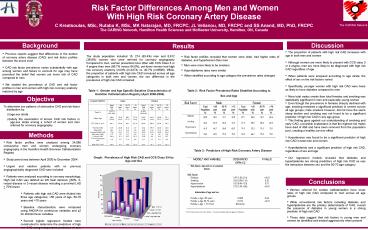Risk Factor Differences Among Men and Women - PowerPoint PPT Presentation
1 / 1
Title:
Risk Factor Differences Among Men and Women
Description:
C Kreatsoulas, MSc, Rutaba K, MSc, MK Natarajan, MD, FRCPC, ... main stenosis 50%, 3-vessel disease or 2-vessel disease including a proximal LAD 70% lesion ... – PowerPoint PPT presentation
Number of Views:51
Avg rating:3.0/5.0
Title: Risk Factor Differences Among Men and Women
1
Risk Factor Differences Among Men and Women
With High Risk Coronary Artery Disease C
Kreatsoulas, MSc, Rutaba K, MSc, MK Natarajan,
MD, FRCPC, JL Velianou, MD, FRCPC and SS Anand,
MD, PhD, FRCPC The CARING Network, Hamilton
Health Sciences and McMaster University,
Hamilton, ON, Canada
The CARING Network
Background
Discussion
Results
- The proportion of patients with high risk CAD
increases with age in both men and women - Although women are more likely to present with
CCS class 3 or 4 angina, men are more likely to
be diagnosed with high risk CAD regardless of age
- When patients were analysed according to age
strata, the effect of sex on the risk factors
varied - Specifically, younger women with high risk CAD
were twice as likely to have diabetes compared to
men - More total males smoke than total females and
smoking was statistically significant in men and
especially young women - Even though the prevalence in females sharply
declined with age, smoking remained a significant
predictor in women across all age groups male
smokers however, did not have the same sharp
decline and smoking was not found to be a
significant predictor of high risk CAD in any age
group - This finding goes against our understanding of
smoking and early CAD a possible explanation is
that the highest risk males have died of AMI and
have been removed from the population pool,
creating a healthy survivor effect - Hypertension was found to be a significant
predictor of high risk CAD in total men and women - Hyperlipidemia was a significant predictor of
high risk CAD, regardless of sex and age - Our regression models revealed that diabetes
and hyperlipidemia are strong predictors of high
risk CAD as was the interaction between sex and
the 50-70 age category
- Previous reports suggest that differences in
the burden of coronary artery disease (CAD) and
risk factor profiles between the sexes exist - CAD risk factor prevalence varies substantially
with age among women and failure to account for
age may have promoted the belief that women are
lower risk of CAD compared to men - We studied the prevalence of CAD and risk
factor profiles in men and women with high risk
coronary anatomy matched by age
The study population included 15, 274 (63.4) men
and 8,812 (36.6) women who were referred for
coronary angiography Compared to men, women
presented more often with CCS Class 3 or 4 angina
than men (66.7 versus 64.5), yet fewer women
had high risk coronary anatomy (24.9 (n2274)
vs. 40.7 (n6626). While, the proportion of
patients with high risk CAD increased across all
age categories in both men and women, the sex
difference in the prevalence of high risk CAD
remained.
- Risk factor profiles revealed that women were
older, had higher rates of diabetes, and
hypertension than men - Men were more likely to be smokers
- Hyperlipidemia rates were similar
- When stratified according to age category the
prevalence rates changed
Table 1 Gender and Age Specific Baseline
Characteristics of Hamilton Catheterization
Registry (April 2000-2004)
Table 2 Risk Factor Prevalence Rates Stratified
According to Sex and Age
Objective
- To determine sex patterns of obstructive CAD and
risk factor distribution by - age-sex strata
- study the association of known CAD risk factors
in age-sex strata among a cohort of women and men
referred for coronary angiography
Methods
- Risk factor profiles were analysed among 24,086
consecutive men and women undergoing coronary
angiography in the Hamilton Health Sciences
Catheterization Registry - Study period was between April 2000 to December
2004 - Urgent and elective patients with no previous
angiographically diagnosed CAD were included - Patients were analysed according to coronary
morphology High risk CAD was defined as left
main stenosis gt50, 3-vessel disease or 2-vessel
disease including a proximal LAD gt 70 lesion - Patients with high risk CAD were divided into
three age categories lt50 years of age, 50-70
years and gt70 years - Baseline characteristics were compared using
ANOVA for continuous variables and ?2 for
dichotomous variables - Several logistic regression models were
constructed to determine the predictors of high
risk CAD using independent predictors of sex,
age, risk factors and interaction terms
Table 3 Predictors of High Risk Coronary Artery
Disease
Graph Prevalence of High Risk CAD and CCS Class
3/4 by Age and Sex
Conclusions
- Women referred for cardiac catheterization have
lower rates of high risk CAD compared to men
across all age groups - While conventional risk factors including
diabetes and hyperlipidemia are the primary
determinants of CAD, overall the presence of
diabetes in young women is a strong predictor of
high risk CAD - These data suggest that risk factors in young
men and women be identified and treated
aggressively when present































